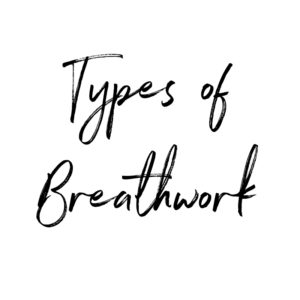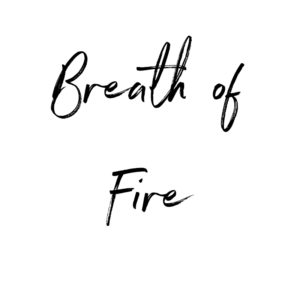
Our breath is our life force energy. Without our breath we cease to exist. It’s the first thing we experience when we enter this world and the last thing that diminishes when our souls depart from our human vessel.
What is breathwork?
Breathwork is the term that describes the healing practice of consciously controlling one’s breath with the intention of influencing your mental, emotional and/or physical state.
Benefits of practicing breathwork may include:
Activating the parasympathetic nervous system
Slowing down your heart rate
Lowering your blood pressure
Relaxing the body, mind and spirit
Reaching a deeper state of mind
Slowing down racing thoughts
Calming and focusing your mind
Removing your ego
Connecting to your true self
Natural painkiller
Improved blood flow
Increased energy
Better posture
Reduced inflammation
Stimulates lymphatic system
Improved digestion

1. Pranayama
Prana (controlling) yama (breath) is the practice of controlling your breath for positive effects. Controlling your breath allows you to move past or through emotional and energetic blockages that disrupt the flow of life force energy.
2. Holotropic
Holotropic is a practice that is often accompanied with intense music and led by an instructor. This practice involved inhaling and exhaling for the same amount of time at different speeds to induce an altered state of consciousness.
3. Rebirthing
Rebirthing breathwork is a practice that involves using circular breathing and often lying mostly underwater to encourage a state of relaxation. The idea behind rebirthing breathwork is that it helps you release residual stress from birth or early life.

Below are some of our favorite breathwork practices.
If you are pregnant, have high blood pressure, heart disease or a hernia, please consult you physician before adopting any of these practices.
Breath of Fire or Kapalabahti in Sanskrit, is an energizing and mentally stimulating practice. The literal translation of Kapalabahti is “skull-shining breath.” It is a foundational breath technique used in the practice of Kundalini Yoga. Breath of Fire is rapid, rhythmic, continuous, but relaxed.
How to do it:
- To begin, sit in a comfortable position where your spine is straight and your abdomen is not compressed.
- Rest your hands on your knees, palms facing down.
- Bring your awareness to your lower belly. To heighten your awareness, you can place your hands, one on top of the other, on your lower belly rather than on your knees.
- Inhale through both nostrils deeply.
- Contract your low belly or use your hands to gently press on this area, forcing out the breath in a short burst. Breathe of Fire is powered by the navel point and the solar plexus. You expel the air powerfully through the nose by pressing your belly button back towards your spine.
- As you quickly release the contraction, your inhalation should be automatic and passive — your focus should be on exhaling.
- Begin slowly, aiming for 65-70 contractions per minute. Gradually quicken the pace, aiming for 95-105 exhalation/inhalation cycles per minute. Always go at your own pace and stop if you feel faint or dizzy.
- After one minute of the exercise, inhale deeply through the nostrils, and then exhale slowly through your mouth. Depending on your experience level, you may repeat the exercise.
Benefits:
- Releases all of the built up anxiety and nervousness. Breath of Fire forces the diaphragm in and out and this has a direct impact on the Navel center, releasing the emotions as well.
- Readjusts and strengthens the nervous system, promoting more peace and happiness.
- Repairs the balance between the sympathetic and parasympathetic nervous systems.
- Helps to regain control over stressful mental states.
- Helps the heart and circulation by flushing the toxins out of the blood stream.
- Massages the internal organs.
- Releases toxins and deposits from the lungs, mucous lining, blood vessels and other cells.
- Expands the lungs capacity and increases vital strength and energy.
- Strengthens the navel chakra, promoting a greater sense of courage and energy.
- Increases physical endurance and prepares you to act effectively.
- Readjusts the subtle psycho-electromagnetic field of the aura so that the blood becomes energized.
- Reduces addictive impulses for drugs, smoking and bad foods.
- Boosts immune system.


Alternate nostril breathing or Nadi Shodhana in Sanskrit, is a wonderful practice to help ease anxiety and feel grounded.
How to do it:
- Hold your right thumb over your right nostril and inhale deeply through your left nostril.
- At the peak of your inhalation, close off your left nostril with your fourth finger, lift your right thumb, and then exhale smoothly through your right nostril.
- After a full exhalation, inhale through the right nostril, closing it off with your right thumb at the peak of your inhalation, lift your fourth finger and exhale smoothly through your left nostril.
- Continue with this practice for 3 to 5 minutes, alternating your breathing through each nostril. Your breathing should be effortless, with your mind gently observing the inflow and outflow of breath.
Benefits include:
- Infuses the body with oxygen
- Clears and releases toxins
- Reduces stress and anxiety
- Calms and rejuvenates the nervous system
- Helps to balance hormones
- Supports clear and balanced respiratory channels
- Helps to alleviate respiratory allergies that cause hay fever, sneezing, or wheezing
- Balances solar and lunar, masculine and feminine energies
- Fosters mental clarity and an alert mind
- Enhances the ability to concentrate
- Brings balance to the left and right hemispheres of the brain
Actuate, stimulate, and empower.
Release your body’s potential with Artemis.


